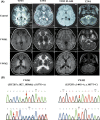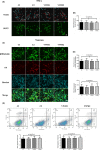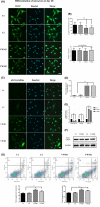Modeling vanishing white matter disease with patient-derived induced pluripotent stem cells reveals astrocytic dysfunction
- PMID: 30720246
- PMCID: PMC6515702
- DOI: 10.1111/cns.13107
Modeling vanishing white matter disease with patient-derived induced pluripotent stem cells reveals astrocytic dysfunction
Abstract
Aims: Vanishing white matter disease (VWM) is an inherited leukoencephalopathy in children attributed to mutations in EIF2B1-5, encoding five subunits of eukaryotic translation initiation factor 2B (eIF2B). Although the defects are in the housekeeping genes, glial cells are selectively involved in VWM. Several studies have suggested that astrocytes are central in the pathogenesis of VWM. However, the exact pathomechanism remains unknown, and no model for VWM induced pluripotent stem cells (iPSCs) has been established.
Methods: Fibroblasts from two VWM children were reprogrammed into iPSCs by using a virus-free nonintegrating episomal vector system. Control and VWM iPSCs were sequentially differentiated into neural stem cells (NSCs) and then into neural cells, including neurons, oligodendrocytes (OLs), and astrocytes.
Results: Vanishing white matter disease iPSC-derived NSCs can normally differentiate into neurons, oligodendrocytes precursor cells (OPCs), and oligodendrocytes in vitro. By contrast, VWM astrocytes were dysmorphic and characterized by shorter processes. Moreover, δ-GFAP and αB-Crystalline were significantly increased in addition to increased early and total apoptosis.
Conclusion: The results provided further evidence supporting the central role of astrocytic dysfunction. The establishment of VWM-specific iPSC models provides a platform for exploring the pathogenesis of VWM and future drug screening.
Keywords: astrocytes; induced pluripotent stem cells; neural stem cells; neurons; oligodendrocytes; vanishing white matter disease.
© 2019 The Authors CNS Neuroscience & Therapeutics Published by John Wiley & Sons Ltd.
Conflict of interest statement
The authors declare no conflict of interest.
Figures






Similar articles
-
Human-induced pluripotent stem cell-derived cerebral organoid of leukoencephalopathy with vanishing white matter.CNS Neurosci Ther. 2023 Apr;29(4):1049-1066. doi: 10.1111/cns.14079. Epub 2023 Jan 17. CNS Neurosci Ther. 2023. PMID: 36650674 Free PMC article.
-
Leukoencephalopathy with vanishing white matter: a review.J Neuropathol Exp Neurol. 2010 Oct;69(10):987-96. doi: 10.1097/NEN.0b013e3181f2eafa. J Neuropathol Exp Neurol. 2010. PMID: 20838246 Review.
-
Secretomics Alterations and Astrocyte Dysfunction in Human iPSC of Leukoencephalopathy with Vanishing White Matter.Neurochem Res. 2022 Dec;47(12):3747-3760. doi: 10.1007/s11064-022-03765-z. Epub 2022 Oct 5. Neurochem Res. 2022. PMID: 36198922
-
Vanishing white matter: a leukodystrophy due to astrocytic dysfunction.Brain Pathol. 2018 May;28(3):408-421. doi: 10.1111/bpa.12606. Brain Pathol. 2018. PMID: 29740943 Free PMC article. Review.
-
Astrocytes are central in the pathomechanisms of vanishing white matter.J Clin Invest. 2016 Apr 1;126(4):1512-24. doi: 10.1172/JCI83908. Epub 2016 Mar 14. J Clin Invest. 2016. PMID: 26974157 Free PMC article.
Cited by
-
Comparative Proteome Research in a Zebrafish Model for Vanishing White Matter Disease.Int J Mol Sci. 2021 Mar 8;22(5):2707. doi: 10.3390/ijms22052707. Int J Mol Sci. 2021. PMID: 33800130 Free PMC article.
-
Genotypic and phenotypic characteristics of juvenile/adult onset vanishing white matter: a series of 14 Chinese patients.Neurol Sci. 2022 Aug;43(8):4961-4977. doi: 10.1007/s10072-022-06011-0. Epub 2022 Apr 7. Neurol Sci. 2022. PMID: 35389136 Review.
-
Foetal onset of EIF2B related disorder in two siblings: cerebellar hypoplasia with absent Bergmann glia and severe hypomyelination.Acta Neuropathol Commun. 2020 Apr 15;8(1):48. doi: 10.1186/s40478-020-00929-2. Acta Neuropathol Commun. 2020. PMID: 32293553 Free PMC article.
-
Neural lineage differentiation of human pluripotent stem cells: Advances in disease modeling.World J Stem Cells. 2023 Jun 26;15(6):530-547. doi: 10.4252/wjsc.v15.i6.530. World J Stem Cells. 2023. PMID: 37424945 Free PMC article. Review.
-
Effects of the Small-Molecule ISRIB on the Rapid and Efficient Myelination of Oligodendrocytes in Human Stem Cell-Derived Cerebral Organoids in Patients With Leukoencephalopathy With Vanishing White Matter.CNS Neurosci Ther. 2025 Apr;31(4):e70398. doi: 10.1111/cns.70398. CNS Neurosci Ther. 2025. PMID: 40296303 Free PMC article.
References
-
- Takahashi K, Tanabe K, Ohnuki M, et al. Induction of pluripotent stem cells from adult human fibroblasts by defined factors. Cell. 2007;131(5):861‐872. - PubMed
-
- van der Knaap MS, Pronk JC, Scheper GC. Vanishing white matter disease. Lancet Neurol. 2006;5(5):413‐423. - PubMed
-
- Bugiani M, Boor I, Powers JM, Scheper GC, van der Knaap MS. Leukoencephalopathy with vanishing white matter: a review. J Neuropathol Exp Neurol. 2010;69(10):987‐996. - PubMed
-
- Kaczorowska M, Kuczynski D, Jurkiewicz E, Scheper GC, van der Knaap MS, Jozwiak S. Acute fright induces onset of symptoms in vanishing white matter disease‐case report. Eur J Paediatr Neurol. 2006;10(4):192‐193. - PubMed
-
- Prange H, Weber T. Vanishing white matter disease: a stress‐related leukodystrophy. Nervenarzt. 2011;82(10):1330‐1334. - PubMed
Publication types
MeSH terms
LinkOut - more resources
Full Text Sources
Miscellaneous

